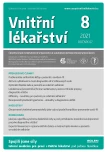What are the specifics of diabetic foot syndrome and why we need interdisciplinary recommendations for its diagnosis and treatment?
Authors:
Alexandra Jirkovská 1; Vladimíra Fejfarová 1; Michal Dubský 1; Veronika Wosková 1; Jiří Jarkovský 2,3; Klára Benešová 2,3; Tomáš Pavlík 2,3
Authors‘ workplace:
Centrum diabetologie Institutu klinické a experimentální medicíny, Praha
1; Ústav zdravotnických informací a statistiky ČR, Praha
2; Institut biostatistiky a analýz, Lékařská fakulta Masarykovy univerzity, Brno
3
Published in:
Vnitř Lék 2021; 67(8): 489-494
Category:
Overview
The care of patients with diabetic foot syndrome (DFS) requires interdisciplinary cooperation, and therefore interdisciplinary recommendations focused on the diagnosis and treatment and prevention of DFS are in place. We also need these recommendations because DFS has its own specifics that affect its diagnosis, therapy, but also the prognosis of patients. These include, for example, the different course of infection and PAD in patients with diabetes, the diagnosis of neuropathic Charcot osteoarthropathy, and the frequent association with end stage kidney disease, which worsens the course of SDN and increases its risk. Last but not least, the specifics of DFS include the issue of amputations with a significantly worse prognosis than in people without diabetes. The creation of an interdisciplinary team in foot clinics, providing comprehensive care for patients with DFS according to the recommended procedure, is associated with improved prognosis of patients with DFS, especially the reduction of amputations.
Keywords:
amputation – diabetic foot syndrome – infection – PAD – Charcot osteoarthropathy
Sources
1. Schaper NC, van Netten JJ, Apelqvist J et al. IWGDF Guidelines on the prevention and management of diabetic foot disease: IWGDF; 2019 [updated; cited 2020 01-30]. Available from: https://iwgdfguidelines.org/wp‑content/ uploads/2019/05/IWGDF‑Guidelines- 2019.pdf
2. Paisey RB, Abbott A, Levenson R et al. Diabetes‑related major lower limb amputation incidence is strongly related to diabetic foot service provision and improves with enhancement of services: peer review of the South‑West of England. Diabet Med. 2018; 35(1): 53–62.
3. Jirkovská A, Lacigová S, Rušavý Z, Bém R. Doporučený postup pro prevenci, diagnostiku a terapii syndromu diabetické nohy: 2016 Dostupné na https://www.diab.cz/dokumenty/ standard_diab_noha.pdf
4. Jirkovská A. Syndrom diabetické nohy z pohledu internisty‑podiatra. Vnitr Lek. 2016; 62(Suppl. 4): 42–47.
5. Rogers L, Frygberg R, Armstrong D et al. The Charcot foot in diabetes. Diabetes Care 2011; 34: 2123–2129.
6. Marmolejo V, Arnold J, Ponticello M et al. Charcot foot. Clinical clues, diagnostic strategies, and treatment principles. Am Fam Physician 2018; 97 (9): 594–599.
7. Lavery LA, Hunt NA, Ndip A et al. Impact of Chronic Kidney Disease on survival after amputation in individuals with diabetes. Diabetes Care 2010; 33(11): 2365–2369.
8. Otte J, van Netten JJ, Woittiez AJJ. The association of chronic kidney disease and dialysis treatment with foot ulceration and major amputation. J Vasc Surg. 2015; 62(2): 406-411.
9.Game FL, Chipchase SY, Hubbard R et al. Temporal association between the incidence of foot ulceration and the start of dialysis in diabetes mellitus. Nephrol Dial Transplant. 2006; 21(11): 3207–3210.
10. Rayman G, Vas P, Dhatariya K et al. on behalf of the International Working Group on the Diabetic Foot. Guidelines on use of interventions to enhance healing of chronic foot ulcers in diabetes (IWGDF 2019 update). Diabetes Metab Res Rev. 2020; 36(Suppl 1): e3283.1
11. Vas P, Rayman G, Dhatariya K et al. Effectiveness of interventions to enhance healing of chronic foot ulcers in diabetes: a systematic review. Diabetes Metab Res Rev. 2020; 36(Suppl 1): e3284.
12. Lefrancois T, Mehta K, Sullivan VS et al. Evidence based review of literature on detriments to healing of diabetic foot ulcers. Foot Ankle Surg. 2017; 23(4): 215–224
13. Armstrong DG, Boulton AJM, Bus SA. Diabetic Foot Ulcers and Their Recurrence. N England J Med. 2017; 376(24): 2367–2375.
14.Dubsky M, Jirkovska A, Bem R et al. Risk factors for recurrence of diabetic foot ulcers: prospective follow‑up analysis in the Eurodiale subgroup. Int Wound J. 2013; 10(5): 555-561.
15. Apelqvist J. Epidemiology of diabetic foot disease and etiology of ulceration. In: Hinchliffe RJ, Schaper N, Thompson M et al., eds. The diabetic foot. 1st ed. London: JP Medical Publishers; 2014: 3–9.
16. Lipsky BA, Aragón‑Sánchez J, Diggle M et al. IWGDF guidance on the diagnosis and management of foot infections in persons with diabetes. Diabetes Metab Res Rev. 2016; 32 Suppl 1: 45–74.
17. Ndosi M, Wright‑Hughes A, Brown S et al. Prognosis of the infected diabetic foot ulcer: a 12-month prospective observational study. Diabet Med. 2018; 35(1): 78–88.
18. Hinchliffe RJ, Forsythe RO, Apelqvist J et al. on behalf of the International Working Group on the Diabetic Foot. Guidelines on diagnosis, prognosis, and management of peripheral artery disease in patients with foot ulcers and diabetes (IWGDF 2019 update). Diabetes Metab Res Rev. 2020; 36(Suppl 1): e3276.
19. Frank U, Nicol S, Belch J + PAD writing group. ESVMB Guideline on peripheral arterial disease.VASA European Journal of Vascular Medicine 2019; 48, Suppl. 102.
20. Fejfarová V, Jirkovská A, Petkov V et al. Comparison of microbial findings and resistance to antibiotics between transplant patients, patients on hemodialysis, and other patients with the diabetic foot. J Diabetes Complications 2004; 18(2): 108–112.
21. Armstrong DG, Lavery LA, American Diabetes Association. Clinical care of the diabetic foot. 3rd edition. ed. Alexandria, Virginia: American Diabetes Association; 2016.
Labels
Diabetology Endocrinology Internal medicineArticle was published in
Internal Medicine

2021 Issue 8
Most read in this issue
- SGLT2 inhibitors – a new pillar for the treatment of heart failure
- Renal parenchymal hypertension: relevant new aspects
- Optimal potassium levels in patients with heart failure
- Antibiotic treatment issues in patients with COVID-19
